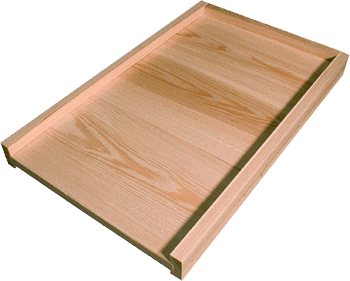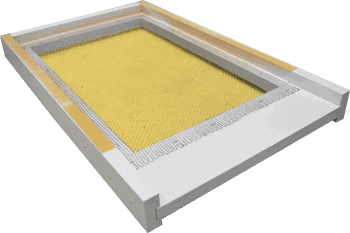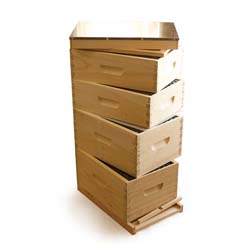Did you know that there are two different types of bottom boards?
New beekeepers may not be aware that there are many types of bottom boards available. Each brings a different set of benefits to the table beekeepers. So let’s look at the benefits of each, so you can decide which type of board most benefits you..
Solid Bottom Boards
I have seen many people use solid bottom boards. But when I first got started no one really explained to me the benefits they could bring. So I automatically jumped to screen bottom boards. However, solid bottom boards definitely deserve a moment of your time and some consideration.
 Solid bottom boards help keep your bees warmer during the blistery winter months.
Solid bottom boards help keep your bees warmer during the blistery winter months.
Because they keep the bees warmer you will find that it will also encourage your bees to brood earlier in the spring.
The bees make brood earlier in the spring.
Because of the extra warmth a solid bottom board provides, you could well find more brood in the bottom of the hive.
No clumping bees under the hive.
I don’t really have this problem with my hive, but if you find that your bees actually clump under your hive a solid board is supposed to deter them from doing that.
Deters fire ants from gathering under your hive.
If you live in a warmer climate with fire ants then you probably are willing to do whatever you can to keep them away from under your hives. Well, bottom boards can help with that too. Because the solid boards catch all of the hive debris then the loose debris will not attract ants to your hives.
It is easier to treat mites.
Some people claim that they have better results at treating mites with solid boards. This would be because there is nowhere for the mites to run. It also means that you have less of an area to have to treat for mites because they won’t fall under your hives.
They are cheap and easy to build.
Another benefit of a solid board is that they are usually cheaper to buy. But they are also cheaper and easier to build too.
But before you get too sold on solid bottom boards let me introduce you to the benefits of screen bottom boards.
Screened Bottom Boards
Truthfully, screen bottom boards are what my husband and I still use in our hives. We have been very satisfied with them and have found no reason to switch all of our hives over to solid bottom boards. That said, some of the benefits listed above are making me want to try them again.
However, screen bottom boards still have a ton of perks and from my experience are probably the better option for where we are in beekeeping.
 Screen bottom boards are helpful with mites.
Screen bottom boards are helpful with mites.
When the bees clean themselves and remove mites, they will fall straight through the hive, instead of laying in the bottom and creating more work for you to clean or for your bees to have to take care of.
Screen bottom boards provide great ventilation.
If you live in a super cold climate then you might need solid bottom boards for warmth. However, we don’t. We live in the south. This means that we have extremely hot summers. Winters can get cold but nothing in comparison to the winters that the north receives.
So for us screen bottom boards work well. You have to remember, bees need air even during the winter. We have found that screened bottom boards allow air to keep circulating. Bees are very smart creatures and know exactly how to regulate their hive’s temperature.
It is easier to see what is going on inside your hive.
Obviously screen is see-through. Therefore, you can spot your queen and any other activity going on within the hive from the bottom if you need to. There are no surprises.
However, it should be mentioned that this benefit only applies if you have a see-through stand (like cinderblock.) And if you are willing to crawl around under your hive. My husband and I get this benefit because we are always on the look out for pests since we live in a wooded spot so we spend a lot of time inspecting under our hives.
And so we often check what is going on in our hives from a bottom view point especially in our larger hives. We have also been able to find our queen when we were struggling to find her in a larger hive because we used screened bottom boards.
Plus, it is a great benefit just to see what kind of activity your bees have going on. But as mentioned, this may not be a benefit many want to take advantage of, understandably so.
So now that we have discussed the benefits of both I want to give you some food for thought.
What Are The Downsides (If Any) To Each Bottom Board?
The Solid Boards Require Cleaning…And It Can Be Gross!
Solid boards obviously do not allow debris to fall through your hive. This means that you will have bugs in the bottom of your hives, pollen, propalis, and bees wax.
So if you aren’t in the mood to pull a carpet like substance out of the bottom of your hive then you will probably not want to go with the solid bottom boards.
The Screen Bottom Boards Mean You Have A Greater Risk Of Pests
Screen bottom boards are mesh. This means that pests can climb up through them. We battle this ourselves.
And even if you try to stop pests then you have to treat your stands, under your hives, and anywhere else they can sneak through because of the mesh. It gets frustrating at times.
They Each Provide Ventilation Issues
Bees need ventilation. If you live in a really cold climate then the screen board might provide a little too much ventilation for your bees. But if you live in a warmer climate then the solid bottom boards could actually make your hives stuffy for the bees.
So this is a personal choice you’ll have to make depending upon where you live.
How Do I Choose?
I recommend that you don’t make a large investment in either if you have multiple hives. If you have only 1 or 2 then I recommend that you make the small investment in one of each and try them out yourself.
This will give you hands on experience for your particular area and the challenges (that all beekeepers face) that are unique to your hive.
For instance, we have friends that also keep bees. Their hives don’t have a single pest in them. But they also keep them in direct sunlight year round.
However, we face challenges with pests because our bees get a mixture of splattered sunlight and full sunlight throughout the day.
So for them, using a screen board might not be that different from using a solid board. For us, solid boards would probably help with the pest problem, but we do still use screen bottom boards for ventilation and cleanliness purposes.
The PerfectBee Store stocks both screened and solid bottom boards, made with cedar which is an excellent insulator.
Solid Bottom Board
Screened Bottom Board
I think choosing a solid or screened bottom board is a personal beekeeping choice, because we all have our bees in different geographical location and locations that vary in sunlight and other elements that can impact our experiences.
But I’d love to hear what you all think. What has been your experience with bottom boards? And which is your particular favorite? And why?
We look forward to hearing from you. Please leave your comments below.
